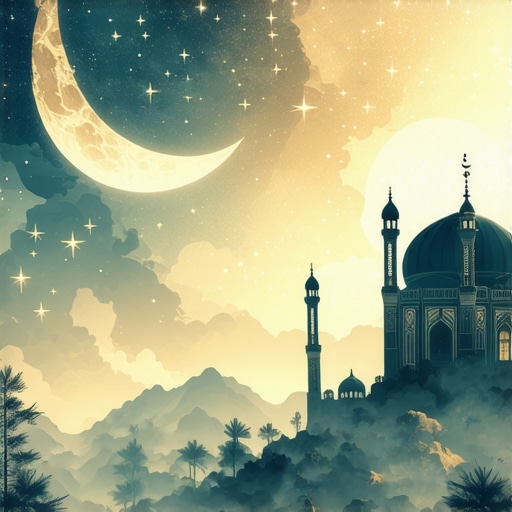My Journey into the Depths of Dreaming and Spiritual Reflection
Recently, I had a profound dream that inspired me to delve deeper into the spiritual significance of dreams in Islam. It was a moment of personal awakening, prompting me to explore the sacred signs that Allah sends through our dreams, especially those related to repentance. Sharing this experience, I hope it resonates with others seeking spiritual cleansing and divine guidance.
Understanding the Sacred Signs of Repentance in Islamic Dreams
In my dream, I saw a luminous mosque pulpit, a symbol often associated with divine messages and spiritual authority. This imagery made me realize how dreams can serve as sacred signs from Allah, guiding us towards repentance and inner purity. According to Islamic teachings, dreams are a form of divine communication, especially when they evoke feelings of remorse or the urge to seek Allah’s forgiveness. For more insights, I recommend exploring the significance of mosque pulpits in dreams.
How Do Dreams Reflect Our Inner Spiritual State?
Reflecting on my dream, I realized that Allah may use symbols like snakes, darkness, or even the image of a person seeking forgiveness to indicate the need for spiritual cleansing. In Islamic dream interpretation, such symbols are potent indicators of our inner state—whether we are in a state of sin, remorse, or readiness for renewal. I often turn to trusted sources like dreams about losing teeth to understand the messages behind my dreams better.
What Does It Mean to Dream of Repentance and Divine Signs?
Dreams of repentance are especially powerful, often signaling Allah’s mercy and the opportunity for spiritual rebirth. In my experience, such dreams serve as divine reminders that Allah is always near, ready to forgive those who sincerely seek His mercy. Recognizing these signs requires mindfulness and a sincere heart, as dreams can be a bridge between our worldly struggles and divine grace.
If you find yourself dreaming of repenting or seeing sacred symbols, I encourage you to take these visions seriously. Engage in sincere istighfar (repentance), perform prayers, and seek knowledge about Allah’s mercy. Sharing your experiences can be helpful; feel free to comment below with your reflections or questions about your dreams.
For further understanding, you might explore dreams of pregnancy in Islam, which also carry deep spiritual meanings related to growth and renewal.
Remember, Allah’s signs are everywhere—within our dreams, our lives, and our hearts. Embracing these signs with humility and faith can lead us to profound spiritual cleansing and closer connection to Allah.
The Hidden Language of Symbols in Islamic Dreams
Dreams in Islam are considered a form of divine communication, often filled with rich symbolism that conveys messages from Allah. Recognizing these symbols requires a nuanced understanding of Islamic dream interpretation, where each image or scenario can carry profound spiritual meaning. For instance, dreaming of a earthquake might symbolize a divine shift or impending change, urging believers to prepare spiritually. Conversely, dreams involving dark snakes often serve as warnings about hidden enemies or spiritual dangers. Understanding these signs can help believers navigate their spiritual journey more consciously.
The Role of Sacred Signs in Personal Growth and Spiritual Reflection
Islamic scholars emphasize that dreams serve as tools for personal reflection and divine guidance. When we encounter symbols like the mosque pulpit, it often points towards spiritual leadership, a call to seek knowledge, or a reminder to strengthen our faith. Similarly, dreaming of keys may symbolize unlocking divine secrets or gaining access to hidden wisdom, reinforcing the importance of spiritual seeking.
How Can We Differentiate Sacred Signs from Personal Symbols?
One of the challenges in dream interpretation is distinguishing between sacred messages and personal symbols rooted in subconscious thoughts. Experts advise that context, emotional state, and the presence of specific symbols play crucial roles. For example, a dream of prophets or companions often indicates divine approval or guidance, whereas personal symbols like a familiar object may simply reflect personal concerns. Developing a mindful approach, such as prayer and supplication, can help clarify these messages and ensure their spiritual authenticity.
Tools and Resources for Accurate Dream Interpretation in Islam
For those eager to deepen their understanding, consulting authentic Islamic dream dictionaries or scholars is invaluable. Resources like interpretations of dreams by opposites shed light on complex symbols, aiding believers in deciphering messages with accuracy. Additionally, books on authentic dream interpretations can serve as guides to navigate the spiritual landscape of dreams confidently.
Have you experienced dreams rich with symbolism that felt like divine messages? Sharing your insights or asking questions can foster a community of spiritual growth. Feel free to comment below, and explore more about dreams of pregnancy in Islam for deeper spiritual insights.
The Power of Intention and Prayer in Interpreting Dreams
Finally, remember that the intention behind interpreting dreams significantly influences their impact. Engaging in sincere prayer and seeking Allah’s guidance before and after sleep can enhance the clarity of divine messages. Islam encourages believers to approach dreams with humility, knowing that Allah’s wisdom surpasses our understanding. By maintaining a humble heart and a sincere desire for truth, believers can unlock the sacred secrets embedded within their dreams, aligning their spiritual path with divine will.
Reflecting on Personal Encounters with Divine Dream Symbols
My journey into the subtle realm of Islamic dreams has been filled with moments of awe and introspection. One experience that profoundly impacted me was a dream where I saw an ancient well, a symbol often associated with divine secrets and spiritual purification. This dream prompted me to question how these symbols serve as gateways to divine knowledge and personal growth. As I delved deeper, I realized that such visions are not mere coincidences but sacred signs calling us to explore our inner worlds with humility and faith.
Unveiling the Nuances of Sacred Symbols in Dreams
Understanding the layered meanings behind symbols like wells, keys, or even celestial bodies requires more than surface interpretation. These images often carry complex messages that depend on context, emotional state, and personal circumstances. For instance, dreaming of a well might symbolize a quest for divine wisdom, but it can also indicate spiritual drought if the well appears dry or neglected. In my practice, I refer to trusted sources like dreams about losing teeth to discern the underlying messages and align my actions with divine guidance.
How Can We Engage More Intimately with Dream Symbols to Foster Spiritual Growth?
To deepen our connection with these signs, I’ve found that intentional prayer before sleep, asking Allah for clarity and guidance, significantly enhances the clarity of divine messages. It’s also crucial to maintain a sincere heart and approach dreams with humility, recognizing that understanding is a gradual process. Keeping a dream journal helps track recurring symbols and themes, revealing patterns that may point toward specific spiritual lessons or warnings. For example, dreaming of a mosque pulpit repeatedly might urge me to seek knowledge or spiritual leadership within my community.
What are the Advanced Layers of Interpretation That I Have Discovered Through Personal Reflection?
One of the most profound insights I’ve gained is that certain symbols, like the black snake, can carry multiple meanings depending on the dreamer’s state and the context. They might signify hidden dangers, spiritual tests, or opportunities for transformation. Recognizing these layers requires not only knowledge but also spiritual intuition cultivated through prayer and reflection. Consulting authoritative texts, such as dream interpretation by opposites, has helped me develop a more nuanced understanding of these symbols.
If you have encountered dreams filled with sacred symbols that challenged or guided you, I invite you to share your experiences. Reflecting together can illuminate the diverse ways Allah communicates with us through dreams, reinforcing our faith and commitment to spiritual growth.
Embracing the Sacred Language of Dreams to Enhance Faith
Ultimately, engaging consciously with the sacred language of dreams fosters a deeper trust in Allah’s divine wisdom. It encourages us to act with humility, seek knowledge sincerely, and remain attentive to divine signs in our daily lives. Remember that every symbol, every vision, is a part of Allah’s gentle guidance. By approaching these dreams with an open heart and a sincere desire for understanding, we can unlock profound spiritual insights that uplift and purify our souls.
Unraveling the Layers of Sacred Dream Symbols in Islamic Esotericism
As my journey into the realm of Islamic dream interpretation deepens, I find myself increasingly captivated by the intricate layers of symbolism that Allah embeds within our visions. These symbols are not mere images but are gateways to divine wisdom, requiring a nuanced understanding that transcends basic interpretations. For instance, dreaming of celestial phenomena like the moon can signify spiritual enlightenment, but its phases and interactions with other symbols reveal complex messages about divine timing and spiritual cycles.
Engaging with these symbols demands a refined spiritual intuition, cultivated through consistent prayer, reflection, and scholarly study. I often consult authoritative texts such as dream interpretation by opposites to decode the multifaceted meanings that Allah may be conveying. This layered approach allows us to differentiate between superficial images and profound divine messages, fostering a more authentic connection with Allah’s guidance.
How Can Advanced Dream Interpretation Elevate Our Spiritual Awareness and Personal Transformation?
Advanced interpretation involves recognizing not only the symbols but also their contextual interplay within our lives. For example, dreaming of dark snakes can indicate spiritual dangers that are hidden beneath surface appearances, demanding vigilance and proactive spiritual defense. Such insights serve as sacred warnings, prompting us to refine our character and strengthen our faith.
Furthermore, engaging with these complex symbols deepens our understanding of divine will, encouraging us to align our actions more consciously with Allah’s plan. This process is supported by continuous learning, sincere supplication, and community discussions. I invite you to explore these advanced insights further by sharing your own experiences or questions—your reflections can illuminate the diverse ways Allah communicates with us through our dreams.
To enhance your journey, consider consulting resources like authentic dream interpretation books that delve into sacred symbols and their hidden meanings. Embracing this layered understanding not only enriches your spiritual life but also empowers you to navigate life’s challenges with divine wisdom.
How Do Sacred Dream Symbols Interact with Our Inner Nafs and Divine Will?
One of the most profound realizations I’ve encountered is how these symbols serve as a dialogue between the nafs (self) and divine will. Dreams involving loss of teeth, for example, can symbolize the nafs’s purification or the need to shed egoistic tendencies to align more fully with Allah’s commands. These visions act as sacred catalysts for inner transformation, urging us to purify our intentions and elevate our spiritual state.
Recognizing the interaction between subconscious impulses and divine messages requires a disciplined heart and a keen spiritual eye. I find that maintaining a meticulous dream journal, reflecting on recurring symbols, and engaging in regular supplication help me discern the authentic divine guidance from personal subconscious echoes. This meticulous approach ensures that my interpretations remain anchored in Islamic teachings and divine authenticity.
In What Ways Can We Cultivate a More Intimate Connection with Sacred Dream Symbols to Accelerate Personal and Spiritual Growth?
Developing intimacy with sacred symbols is an ongoing spiritual practice. I recommend starting with sincere prayer, asking Allah for clarity and protection before sleep. Coupled with this, keeping a detailed dream journal allows us to observe patterns and decode deeper meanings over time. For instance, repeatedly dreaming of keys can symbolize unlocking divine secrets, emphasizing the importance of spiritual seeking and divine trust.
As we deepen our engagement, our intuition becomes more refined, enabling us to perceive subtle signs that guide our journey. I encourage you to explore these methods and share your experiences—your insights can contribute to a collective understanding of how Allah communicates through dreams. Remember, every sacred symbol is a divine gift, an opportunity to elevate our faith and understanding.
<
Things I Wish I Knew Earlier About Dream Interpretation in Islam
The Power of Symbols in Dreams
One thing I wish I understood sooner is how deeply symbols in dreams connect to our spiritual journey. For example, dreaming of a mosque pulpit can be a divine sign urging us to seek knowledge and spiritual leadership, something I only fully appreciated after studying Islamic dream interpretations more closely. Recognizing such symbols can transform our understanding of divine messages.
The Importance of Context
Initially, I thought all dreams carried the same meaning, but I learned that context is everything. A snake might symbolize danger in one dream but protection in another, depending on the situation. This realization helped me approach dreams with more patience and humility, knowing that divine signs require careful reflection.
Dreams as Divine Guidance
I used to dismiss dreams as mere subconscious images, but now I see them as a form of divine communication, especially when they evoke feelings of remorse or urge us toward repentance. Dreams can serve as gentle reminders from Allah to evaluate our inner state and seek forgiveness.
The Role of Personal Reflection
Keeping a dream journal has been transformative. Recording recurring symbols like keys or wells has helped me notice patterns and messages I might otherwise overlook. This practice deepens my connection with divine guidance and enhances my spiritual growth.
Seeking Knowledge with Sincerity
Learning about dream symbolism is important, but approaching it with sincerity and prayer is even more crucial. Asking Allah for clarity before sleep can help clarify divine messages and ensure our interpretations align with Islamic teachings.
Resources I’ve Come to Trust Over Time
- Al-Nabulsi’s Dream Interpretation: This classical text has been invaluable in understanding complex symbols and their meanings, providing a solid foundation for my studies.
- Islamic Dream Dictionary by Ibn Sirin: A trusted resource that offers detailed explanations of common dream symbols, helping me decode messages more accurately.
- Online Islamic Scholar Forums: Engaging with knowledgeable scholars online has allowed me to ask questions and gain diverse perspectives on dream interpretation.
Parting Thoughts from My Perspective
Understanding the sacred signs in dreams within Islam has been a deeply personal and spiritual journey. Recognizing symbols like the mosque pulpit or keys can serve as gateways to divine wisdom, guiding us through life’s challenges with faith and humility. I encourage anyone exploring this path to approach dreams with sincerity, patience, and an open heart. If this resonated with you, I’d love to hear your thoughts or experiences—sharing our journeys can strengthen our collective faith. Feel free to comment below or reach out through the contact page. Remember, every dream is a sacred message from Allah, waiting for us to listen and reflect upon it.


